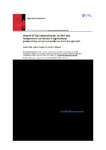Impact of R&D expenditures, rainfall and temperature variations in agricultural productivity: empirical evidence from Bangladesh
| dc.contributor.author | Salim, R | |
| dc.contributor.author | Hassan, K | |
| dc.contributor.author | Rahman, Sanzidur | |
| dc.date.accessioned | 2020-07-10T08:22:21Z | |
| dc.date.issued | 2019-12-06 | |
| dc.identifier.issn | 0003-6846 | |
| dc.identifier.issn | 1466-4283 | |
| dc.identifier.uri | http://hdl.handle.net/10026.1/15976 | |
| dc.description.abstract |
This study aims to investigate dynamic relationships between research and development (R&D) expenditure, climate change (measured by annual rainfall and temperature variations), human capital (proxied by literacy) and total factor productivity (TFP) growth in Bangladesh agriculture. Pesaran’s Pooled Mean Group (PMG) estimator is used to a unique panel data of 17 regions of Bangladesh covering a 61-year period (1948–2008). In addition, the panel vector autoregression (PVAR) model is also applied to trace the responsiveness of TFP from a shock to R&D, extension services, and literacy rate. Results reveal that R&D has an insignificant impact on TFP in the short-run, while it has a significant positive impact in the long-run. The contributions of climate variables (i.e., rainfall and temperature variations) are highly significant and negative in the long run. The literacy rate is found to have a significant positive impact on TFP as expected. These results suggest that agricultural R&D investment and human capital could play an important role to ameliorate the adverse effects of climate change in the agricultural sector of Bangladesh. | |
| dc.format.extent | 2977-2990 | |
| dc.language | en | |
| dc.language.iso | en | |
| dc.publisher | Informa UK Limited | |
| dc.subject | Total factor productivity | |
| dc.subject | R&D expenditure | |
| dc.subject | panel data | |
| dc.subject | Bangladesh | |
| dc.title | Impact of R&D expenditures, rainfall and temperature variations in agricultural productivity: empirical evidence from Bangladesh | |
| dc.type | journal-article | |
| dc.type | Journal Article | |
| plymouth.author-url | https://www.webofscience.com/api/gateway?GWVersion=2&SrcApp=PARTNER_APP&SrcAuth=LinksAMR&KeyUT=WOS:000501555000001&DestLinkType=FullRecord&DestApp=ALL_WOS&UsrCustomerID=11bb513d99f797142bcfeffcc58ea008 | |
| plymouth.issue | 27 | |
| plymouth.volume | 52 | |
| plymouth.publication-status | Published | |
| plymouth.journal | Applied Economics | |
| dc.identifier.doi | 10.1080/00036846.2019.1697422 | |
| plymouth.organisational-group | /Plymouth | |
| plymouth.organisational-group | /Plymouth/Faculty of Arts, Humanities and Business | |
| plymouth.organisational-group | /Plymouth/Users by role | |
| dcterms.dateAccepted | 2019-08-05 | |
| dc.rights.embargodate | 2020-7-13 | |
| dc.identifier.eissn | 1466-4283 | |
| dc.rights.embargoperiod | Not known | |
| rioxxterms.versionofrecord | 10.1080/00036846.2019.1697422 | |
| rioxxterms.licenseref.uri | http://www.rioxx.net/licenses/all-rights-reserved | |
| rioxxterms.licenseref.startdate | 2019-12-06 | |
| rioxxterms.type | Journal Article/Review |


